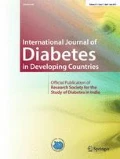Dear Sir,
Prevalence of diabetes in India is rising in astronomical proposition, so does its complication. Oral cavity is no exception. The risk of developing complications is significantly reduced by healthy eating, regular physical activity and having well-controlled blood glucose levels. Since the consumption of simple or refined carbohydrates like sucrose increases the blood glucose levels quickly, the dietary practice of consuming complex carbohydrates has a great role in having well-controlled blood glucose levels and development of long-term complication in diabetic patient.
Therefore, from the dental perspective, one could expect that such dietary practice of lower intake of refined carbohydrates not to favour the growth of cariogenic bacteria and the subsequent development of carious lesions in diabetics [1]. But the incidence of dental caries in diabetics is higher when compared to non-diabetics. This is surprising in view of the fact that the lower intake of refined carbohydrates, especially sucrose, and high protein content of the diet make the diabetic subjects clearly less cariogenic than among non-diabetics. This difference can be attributed to the complications of diabetes which are based on microvascular and macrovascular changes.
Normal salivary function is essential to the preservation of the integrity of teeth and oral soft tissues. Salivary glands act as a filter of blood glucose that would be altered by hormonal or neural regulation [2]. But microvascular damage alters basement membrane in salivary gland, leading to increased leakage of glucose from ductal cells. This results in increased glucose levels in saliva and crevicular fluid which causes decreased fibroblastic activity which in turn produces increased plaque accumulation. The glucose released into the saliva is metabolized to lactic acid by plaque. This results in decreased salivary pH and increases acidophilic bacteria. Long-term glucose leakage into saliva is likely to increase the metabolic activity of the oral microflora. This changes the natural balance of the dental biofilm [3] and causes dental decay and periodontal diseases.
The acidic pH of saliva in diabetics may be associated either to microbial activity or to decreased levels of bicarbonate with decreased salivary flow rate. So, when treating diabetic patients, practitioners should be alert to complaints of dry mouth and signs of decreased salivary function. Hyosalivation may be indicative of poor glycemic control in some of these patients [4].
Lack of patient knowledge on the association of oral health with maintaining metabolic control of diabetes is a significant challenge to prevent the oral health complications. Hence, children and adolescents with poorly controlled or uncontrolled diabetes exhibit higher incidence of caries inspite of extensive preventive efforts.
References
Tenovuo J, Alanen P, Larjava H, Viikari J, Lehtonen OP. Oral health of patients with insulin-dependent diabetes mellitus. Scand J Dent Res. 1986;94:338–46.
Aren G, Sepet E, Ozdemir D, Dinççağ N, Güvener B, Firatli E. Periodontal health, salivary status and metabolic control in children with type 1 diabetes mellitus. J Periodontol. 2003;74:1789–95.
Siudikiene J, Machiulskiene V, Nyvad B, Tenovuo J, Nedzelskiene I. Dental caries increments and related factors in children with type 1 diabetes mellitus. Caries Res. 2008;42:354–62.
Moore PA, Guggenheimer J, Etzel KR, Weyant RJ, Orchard T. Type 1 diabetes mellitus, xerostomia, and salivary flow rates. Oral Surg Oral Med Oral Pathol Oral Radiol Endod. 2001;92:281–91.
Author information
Authors and Affiliations
Corresponding author
Rights and permissions
About this article
Cite this article
Hariharavel, V.P., Rao, A.P.V., Venugopal, R.N. et al. Diabetes, diet and dental caries. Int J Diabetes Dev Ctries 37, 94 (2017). https://doi.org/10.1007/s13410-015-0400-6
Received:
Accepted:
Published:
Issue Date:
DOI: https://doi.org/10.1007/s13410-015-0400-6

